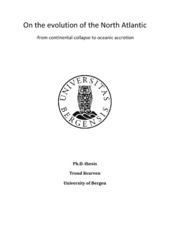On the evolution of the North Atlantic -from continental collapse to oceanic accretion
Doctoral thesis
Permanent lenke
https://hdl.handle.net/1956/7522Utgivelsesdato
2013-10-23Metadata
Vis full innførselSamlinger
- Department of Earth Science [1050]
Sammendrag
The North Atlantic between Iceland and Svalbard and surrounding continental areas represent an ideal laboratory for studying plate tectonic processes, due to the presence of well exposed continent-continent collision terranes on the Norwegian mainland and dense coverage of offshore geophysical data documenting subsequent extensional processes, continental break-up and formation of oceanic crust. Interpretation of crustal-scale wide-angle seismic models suggests that the main Caledonian suture might be linked with bodies of lower crustal eclogites localized along the Norwegian continental margin (e.g. Mjelde et al., 2010). Since terrains of eclogites are exposed in the Western Gneiss Region, a wide-angle seismic profile was acquired across the onshore transition in this area. The main aim with the research work presented in Paper 1 (this thesis) is to identify possible lower crustal high-velocity bodies, and thus the suture, in this region. Paper 2 aims at interpreting the suture from the North Sea to Svalbard, by use of available crustal scale models. Furthermore, paper 2 discusses the back-stripping of two crustal-scale transects across the Atlantic, in order to identify the dominant tectono-magmatic processes active at various stages of the area’s geological evolution. The two transects are located on opposite sides of the Jan Mayen Fracture Zone, which assures that possible change from upper to lower plate configuration along strike can be addressed. Paper 3 focuses on interpretation of multi-channel seismic data from the Knipovich Ridge. The main aim with this study is to reveal the interplay between tectonism and magmatism along this ultra-slow oceanic spreading ridge. Furthermore, the sedimentary processes transporting huge amounts of sediments from Svalbard, and their interaction with the spreading ridge, will be addressed. The main contribution with this thesis is that it discusses a selection of tectonic, magmatic and sedimentary processes active during all stages of ocean basin formation, i.e. collapse of a mountain range, formation of a passive continental margin and active oceanic accretion. In the following chapters I will first briefly describe the tectonic setting and the geological history of the study areas. Secondly, I will explain the different types of data used, and the methods used for the interpretation and modeling. Then, the three papers will be introduced, and lastly I will give a short summary with proposal for future work.
Består av
Paper 1: Crustal structure across the Møre margin, mid-Norway, from wide-angle seismic and gravity data. Full-text not available in BORA.Paper 2: Lower crustal eclogites and structural geometry of the conjugate East Greenland and Norwegian margins. Full-text not available in BORA.
Paper 3: Tectonic and sedimentary processes along the ultraslow Knipovich spreading ridge. Full-text not available in BORA.
